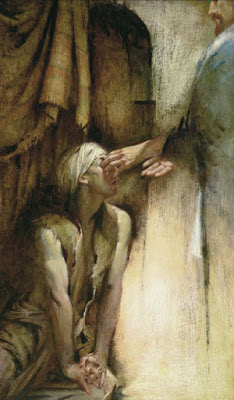4th Sunday of Lent A
Readings: 1 Samuel 16:1,6-7,10-13 Ephesians 5:8-14 John 9:1-41
The Fourth Sunday of Lent presents a rich cluster of baptismal symbols and images (anointing with oil, light vs. darkness, sight vs. blindness) as it challenges us to learn that God’s ways often overturn human expectations and standards. Let us entrust ourselves to the Lord’s mysterious guidance in the words of the responsorial psalm: “The Lord is my shepherd; there is nothing I shall want” (Ps 23:1).
In the first reading, both Samuel and Jesse are confronted with the Lord’s surprising choice of David as the future king of Israel despite his being Jesse’s youngest son who had the lowly job of tending sheep. When Samuel is sent to Bethlehem to designate one of Jesse’s sons to replace the rejected Saul, he naturally expects to anoint the eldest son Eliab, but the Lord tells him, “Do not judge from his appearance or from his lofty stature, because I have rejected him. Not as man sees does God see, because man sees the appearance but the Lord looks into the heart.” After Jesse has presented his seven oldest sons, Samuel again tells him “The Lord has not chosen any of these.” Only as an afterthought does Jesse remember his youngest son David, who is tending sheep; yet, in God’s plan, this unlikely lad is designated as the anointed one who is endowed with the rush of the Lord’s spirit.
The Ephesians reading is an exhortation to the Gentiles, who before their conversion to Christianity were in “darkness” but have now become “light in the Lord.” The letter constantly emphasizes the difference between the standards of the world and those of the Church which has been loved by Christ as a bride and is called to live that love in a hostile environment. In this section, Paul is reminding these converts that at baptism they turned from a fruitless life of darkness (immorality, impurity, greed, obscene talk and idolatry). Now he encourages them to “live as children of the light” by producing “every kind of goodness and justice and truth.” The section concludes with what is probably part of an early Christian baptismal hymn which alerts the believer to the newness of life offered by Christ. “Awake, O sleeper,/ arise from the dead,/ And Christ will give you light.”
Jesus’ curing of the man born blind in John 9 continues the baptismal theme of Jesus as the light of the world. Before he cures the blind man, Jesus announces to his disciples that the man’s physical blindness is not due to sin. Rather, his blindness will serve to manifest the works of God done through Jesus as “the light of the world.” For John, the only sin/blindness is the unbelief of the Pharisees who refuse to accept Jesus as coming from God.
In the dialogues which follow the cure, the blind man comes to gradual belief in Jesus despite official opposition from the Pharisees. During the interrogation by his neighbors, the man admits that he is the one cured by “the man called Jesus.” But when questioned by the Pharisees, who will not accept Jesus as a man from God because he has cured on the Sabbath, the man confesses that Jesus is a “prophet.” His parents, however, will not make any profession of faith, “because they feared the Jews, for the Jews had already agreed that if anyone should confess him to be Christ, he was to be put out of the synagogue.” In a second highly ironic dialogue with the Pharisees, the cured man insists that Jesus must be from God if God has listened to him in opening the eyes of a man born blind. At the same time the Pharisees ironically say that both Jesus and the former blind man are “sinners,” while they are “disciples of Moses.” Finally, after the Pharisees have “cast him out,” the man comes to Jesus and to full belief in him as “Son of Man.”
The incident ends with a final dialogue between Jesus and the Pharisees which ties together the themes of seeing/belief and blindness/sin. After the cured man has worshiped him, Jesus solemnly announces, “For judgment I came into this world, that those who do not see may see, and that those who see may become blind.” The Pharisees then asks, “Are we blind also?” Harkening back to the blind man’s physical blindness and the Pharisees righteous refusal to accept him, Jesus responds, “If you were blind, you would have no guilt; but now that you say, ‘We see,’ your guilt remains.”
As we move toward the renewal of our baptismal commitment at Easter, we are called, like the man born blind, to open our eyes in courageous faith and embrace Jesus as light in a darkened and hostile world.

No comments:
Post a Comment